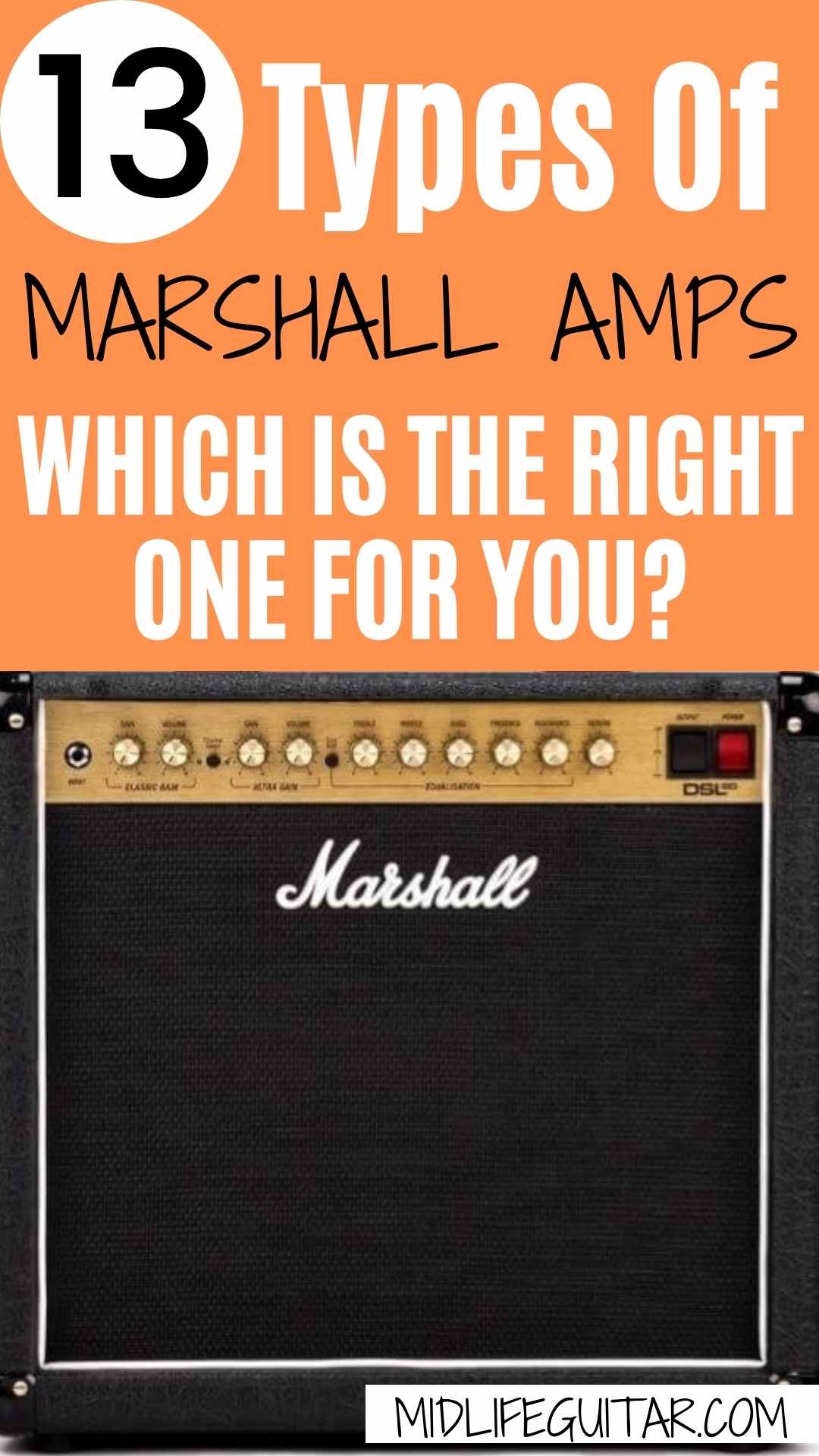
With over 50 decades of producing great amps, Marshall has a huge variety of Marshall amplifiers ranging from 5-watt practice amps to mammoth 100-Watt full-stack amps.
But, with so much history and many different types of amps which is right for you?
In this guide, I will discuss different types of Marshall Amps, providing all the characteristics for each type, price and I will even let you know if the amp suits a beginner, intermediate, or advanced player.
However, If you are wondering whether Marshal amps are good or worth having, my article “is marshall guitar amp good” can help you understand if these amps are the right ones for you!
Let’s start!
| Summary In this article, I describe 13 marshall amp types. In the description, I provide the amp characteristics, the price, and the type of player that will suit the amp. 1. The Marshall Studio Vintage amp, in particular the SV20C, suit intermediate to advanced players. 2. The Marshall Code amp, in particular the Code 25, suit intermediate players. 3. The Marshall MG amp, in particular the MG30FX, suits beginner players. 4. The Marshall DSL amp, in particular the DSL20C, suit intermediate to advanced guitarists. 5. The Marshall JVM amp, in particular the JVM215C, suit advanced guitarists. 6. The Marshall Origin amp, in particular Origin 20C, suits players of all ability levels. 7. The Marshall Bluesbreaker amp, in particular the 1962 Bluesbreaker, suit intermediate to advanced guitarists. 8. The Marshall JTM45 amp, in particular the JTM45, suit advanced guitarists. 9. The Marshall 1974X amp, in particular the 1974X, suit advanced guitarists. 10. The Marshall 1987X amp, in particular the 1987X, suit intermediate to advanced guitarists. 11. The Marshall JCM 800 amp, in particular the JCM800, suit intermediate to advanced players. 12. The Marshall Jubilee amp, in particular the 2525C Silver Jubilee, suit advanced guitarists. 13. The Marshall JCM900 amp, in particular the JCM900 reissue, suit intermediate to advanced guitarists. |
1) Studio Vintage Marshall Amp
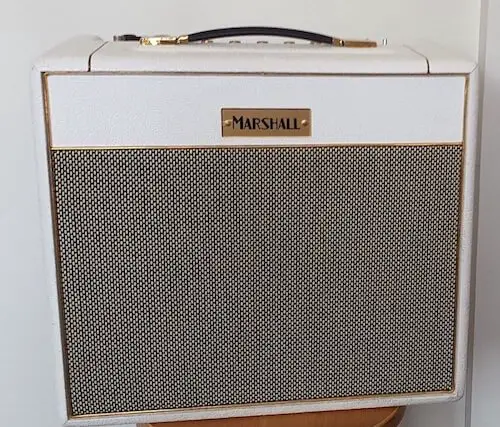
Marshall’s recent Studio series aims to provide classic Marshall tones at lower volumes and affordable prices.
One of these is the Studio Vintage.
It is the first serious reproduction of the classic Marshall Super Lead, as played by Hendrix, at a lower wattage.
The Marshall SV20C is ideal for intermediate to advanced players.
This is because it lacks the versatility and low volume that is typically best for a guitarist in their first year or two of learning.
I own one, and I love it.
This 20W combo amp is designed to replicate the classic Marshall Super Lead tone. It does this with tube speakers.
Ironically, considering the sole aim of the Super Lead was ear-shattering volume, the SV20C is built to produce Marshall roar and crackle at lower volumes.
This amp has four inputs for your digital lead.
Each input represents a high or low powered option for each of the Marshall’s two channels:
- Channel one is the “high treble” channel, and
- Channel two is the “normal” channel.
The high treble channel has a jangling treble sound. I find the tone for this channel too bright, even with the bass EQ turned up.
The normal channel feels like an over-correction of the high treble channel, with a flabby, muddy sound.
However, if you access both channels simultaneously, with a jumper cable, the tones will blend together making the soundincredibly loud, with a fantastic tone…
Even in the low-powered five-watt setting.
| Note: You’ll need to purchase this cable separately as it is not included in the packaging. |
The twenty watts setting has a similar tone to the five watts setting, but it is deeper and more commanding.
I’ve played this amp with a drummer both at rehearsal and in a small club (about 300 capacity) and never needed to play it any higher than halfway.
Playing my reliable little Marshall SV20C has revealed a few tricks to the amp:
- While I thought the lack of built-in reverb or delay would irritate me, It has instead cleaned up my playing immeasurably.
- The Marshall is extremely sensitive to picking dynamics. Soft strokes sound clean and sweet, while harder playing is rewarded with overdrive.
- Even with both channels blended, it retains a lot of treble. I prefer a beefier, warmer tone, so I tend to turn up the normal channel and keep the bright channel reined in.
- Despite boasting a low-power option, this amp isn’t appropriate for practice as it won’t produce Marshall’s luxurious, overdriven tone at low volume. If you’re a bedroom guitarist, you might look into a volume controller pedal. However, for playing with a band, it provides more than enough volume to hold its own against a drummer and PA.
Related: Essential guitar pedals for beginners
- Its natural overdrive does not break into outright high-gain distortion. To achieve fuzzy or extremely distorted tones, you’ll need a dirt box. However, using a suitably high-output guitar with the volume up, you’ll land somewhere near the border of overdrive and distortion. Think more along the lines of Ace Frehley’s live tone on KISS Alive or Angus Young circa Back in Black than Metallica or Slipknot.
- If you want to play metal with this amp, placing a distortion pedal between the guitar and amp or in the effects loop will achieve a saturated, chugging metal distortion. For me, the amp has responded better to a ProCo Rat and my MXR Distortion+, with the addition of either box adding saturation without squashing or compromising the amp’s sound.
This amp is well constructed, with no visible joins, sturdy wood, and the speaker compact in its enclosure.
Characteristics
Volume
Rock and roll was never supposed to dribble out of phone speakers or earbuds.
If you want to rock, you need volume, and this little amp has it in spades.
Marshall amps are LOUD!
A typical all-tube Marshall will provide at least five watts of power, and even these are loud enough to play with a band.
The SV20C has a huge volume jump.
It’s almost inaudible with the volume below one, but with the volume knob at only one or two, it’s loud enough to play with a live drummer or a full band.
Tubes & Speaker
My Marshall SV20C gets its roar and crackle from three ECC83 valves in the preamp and two EL34s in the power amp.
This goes through a single 10″ Celestion V-type speaker offering 16Ω and 50 watts.
Controls
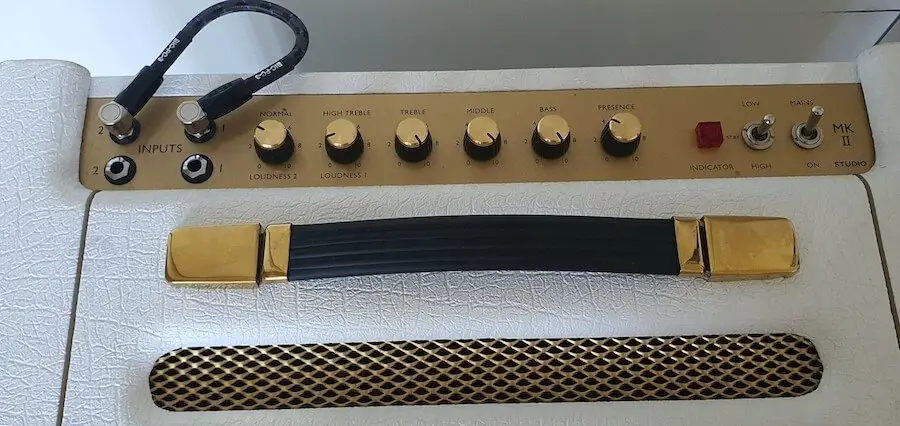
The SV20C has four inputs.
These are high and low power for the “normal” and “high treble” channels.
The amp has various buttons:
- The standard on and off switch.
- A switch for the low and high power mode.
- And knobs to control presence, bass, mids, treble, and the respective volumes for the high treble and normal channels.
Effects & Effects Loop
The SV20C comes with an effects loop, a series send/return.
Dimensions
| Weight | Height | Width | Depth |
|---|---|---|---|
| 15.9 kg | 500 mm | 460 mm | 245 mm |
Price
The SV20C retails for $1,699.99 on Amazon. Your local music store may have a different price.
2. Marshall Code Amplifier

The Marshall Code 25 amp is ideal for intermediate players looking for a versatile gigging amplifier.
Characteristics
Marshall’s Code series is the iconic British brand’s foray into the world of amp modeling.
As modern players demand increasing versatility from their amplifiers, even the almighty Marshall has had to adjust to changing demand.
I recently played in a cover band with a second guitar player, who showed up with a Marshall amp I didn’t recognize.
It had a screen display on the control panel, and he seemed to be working the amp with his phone.
Curious, I asked if I could try this strange beast out.
Unlike most amps, the Marshall Code series offers a variety of preset sounds.
Basically, you pick a tone (such as Metallica’s “Enter Sandman”) and cycle through the presets until you get close.
In this way, gigging guitarists covering a broad repertoire of songs and genres will appreciate the practicality and versatility of this amplifier.
If you want to switch between crushing heavy metal tones and chiming clean sounds in one song, this may well be the amp for you.
The basis of the Code series seems to be the use of every classic Marshall sound.
Super Lead, JCM800, Bluesbreaker, and the JVM models all make appearances in the Code’s presets.
The Code responds well to the use of its inbuilt control panel, but its true potential comes out when you start fiddling with Marshall’s Gateway app.
This mobile or tablet app allows you to connect to the amp via Bluetooth from your device.
This intuitive design more closely resembles the Pro Tools or Neural DSP amp modeling with which modern players will be more familiar.
As such, commanding the broad tonal palette of this amp becomes more manageable when used with the app.
Unfortunately, those seeking an authentic reproduction of Marshall’s classic tone will be disappointed.
The Code series feels more like a Garageband reproduction of a Marshall sound than an actual Marshall.
The amp lacks the touch sensitivity and pleasant saturation of the real thing.
The distorted tones can be harsh or fizzy, particularly at lower volumes.
This Marshall amp does provide delightful, clean sounds and a passable acoustic simulator.
The Code also comes with a wide variety of effects, including:
- overdrive,
- compression,
- pitch-shifting,
- chorus,
- phaser,
- flanger,
- tremolo,
- auto-wah,
- a tuner, and a tap tempo function. And
- a range of reverbs and delays.
The range of effects is a valuable feature and allows you to dial in particular tones for particular songs.
This feature makes the Code best suited to a cover band guitarist who will need a wide variety of tones throughout a single performance.
Many guitarists, myself included, tend to prefer a narrower range of tones, particularly live.
If that sounds like you, you may prefer one of Marshall’s more specialized amplifiers.
Volume
One benefit of the Code series is that it will provide overdriven tones at a lower volume than its tube-equipped brethren.
Depending on which model you get – the Code series goes from 25 up to 100 watts.
You will be accessing the Code’s preset tones anywhere from bedroom volume to full-band power.
When I tried the Marshall Code, it was loud enough to play with a full band, including drummer and PA.
The Code series’ solid-state technology will also allow you to use clean tones at higher volumes.
Marshall’s tube amps are built to overdrive and saturate at high volume, so they tend not to be great for loud, clean playing.
However, most venues these days will mic your amplifier and run it through the PA anyway, so the need for high-volume clean playing may well be a thing of the past.
Tubes & Speaker
Because the Code series is solid-state, it has no tubes built-in.
However, built into the amplifier are fourteen digital imitations of Marshall’s various preamp combinations.
In one amp, you’ll get similar tones to all Marshall’s classic preamp tubes, including the EL34, EL84, 6L6, and 6550.
The various Code combo amps all come with a custom Celestion speaker.
The 50-watt version has a 12-inch speaker, while the 25-watt version uses a 10-inch speaker. The 100-watt Code combo comes with two twelve-inch speakers.
Controls
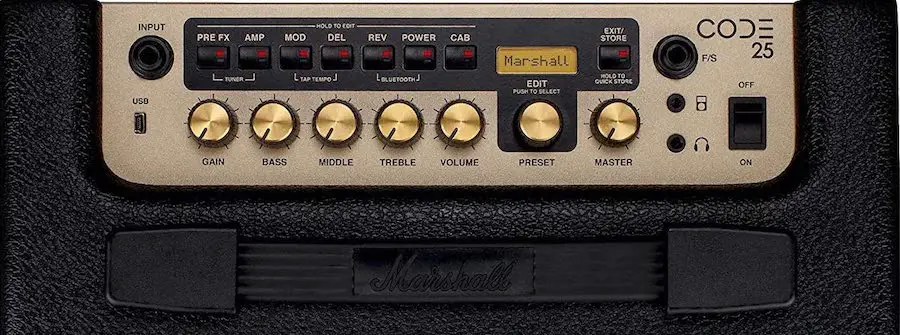
Unique to the Marshall Code series is its control layout.
The Marshall Code is primarily controlled via the Marshall Gateway app, which allows fine-tuning of your tone.
The controls built into the amp include 100 editable presets and Marshall’s usual bass, middle, treble, gain, and volume knobs.
You can also control the pre-FX, which amplifier model you’re simulating, modulation effects, delay effects, reverb, power amplifier model simulation, and speaker cabinet simulation.
Effects & Effects Loop
Unlike conventional Marshall amps, which have an effects loop, the Marshall Code series has various effects built-in.
The effects can easily be categorized as below:
- Pre-FX (stompbox)
- Chorus, flanger, and phaser
- Delay
- Reverb
- Compression
- Pitch shifter (octave dividers or harmonizers)
- Tremolo
- Auto wah
- Tuner
- Tap tempo
You can access even more effects via the Marshall Gateway app.
Dimensions
| Weight | Height | Width | Depth |
|---|---|---|---|
| 7 kg | 15.98 mm | 14.49 mm | 8.86 in |
Price
The Marshall Code 25 retails for $299.99 on Amazon. Your local music store may have a different price.
3. Marshall MG
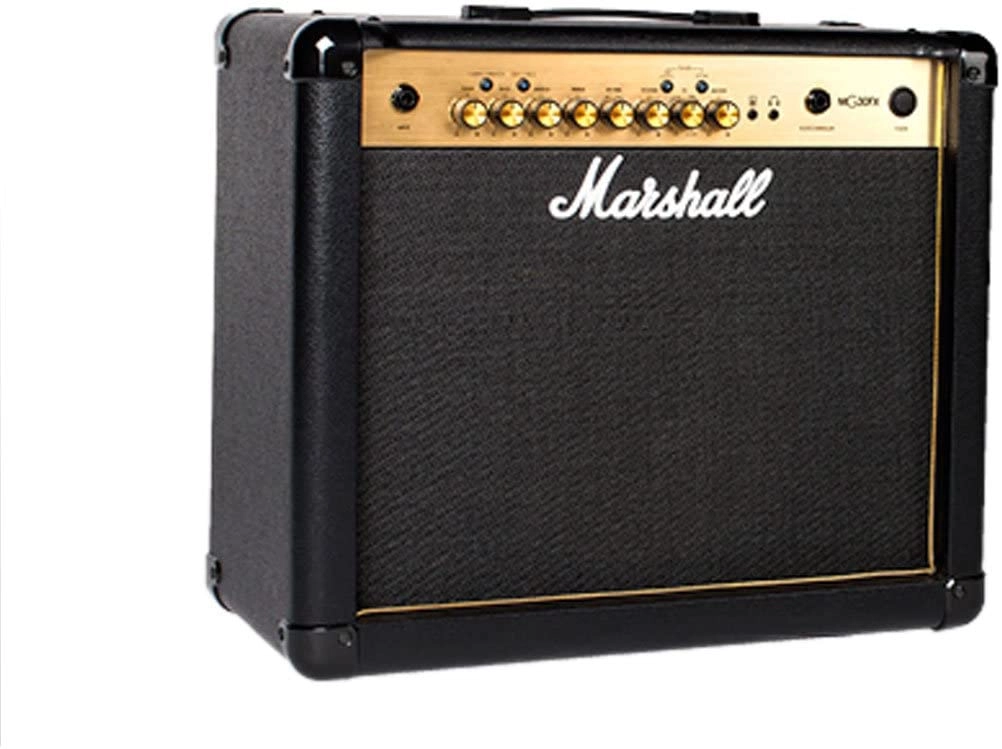
The Marshall MG is ideal for beginners, as the MG series will provide usable distorted and overdriven tones…
But advanced players and those imagining the specific Marshall sound will want to look elsewhere.
Characteristics
In my opinion, the Marshall MG series is the least “Marshall-y” of any Marshall amplifier.
Its solid-state construction won’t deliver the crunching, punishing Marshall tones you’ve heard on countless classic records.
However, for beginners looking to branch out into distortion, the MG series provides a viable option.
As Albert Einstein once said:
“it’s important not to judge a fish on its ability to climb a tree.”
“Albert Einstein”
Nor should one judge a solid-state amp on its ability to sound like a tube amp.
The Marshall MG series does not, to the trained ear, sound like a tube amplifier.
The touch sensitivity, harmonic resonance, and pleasant crunch of a tube amp pushed into overdrive are absent from the Marshall MG.
However, the MG series does provide a passable clean sound and the sort of compressed, fizzy distortion that some modern players prefer.
My taste in distortion leans more vintage than modern, but if you’re more partial to Drowning Pool than AC/DC, the MG series’ inbuilt distortion may be for you.
Volume
The Marshall MG series comes in a variety of sizes, from 10 watts to 100 watts.
If you’re a bedroom player who rarely performs with distortion, the ten-watt MG will probably work for you.
Higher-powered Marshall MG models have larger speakers, providing more than enough volume to play with a drummer or on set.
The MG series also features a headphone jack, which will allow you to play almost silently.
Perfect for players who tend to practice after other people in their home have gone to bed, or whose neighbors are particularly sensitive to noise.
Tubes & Speaker
These solid-state amplifiers do not have tubes.
Each Marshall MG combo amp comes with a custom speaker built-in, ranging from the titchy 6.5″ speaker on the 10-watt model to the twin twelve-inch speakers found in the MG102FX.
Controls

Marshall’s MG series uses the standard control layout, as below.
- Gain
- Channel switching from clean/crunch
- EQ: bass, middle, treble
- Channel boosting OD1/OD2
- Reverb
- Volume
Effects & Effects Loop
The MGFX models have built-in effects.
This allows you to control effects from the control panel, including chorus, phaser, flanger, and vibrato.
The amp also comes with a delay control, a control for external effects units, and a tuner.
The Marshall MG series also has an effects loop.
Marshall MG30FX Dimensions
| Weight | Height | Width | Depth |
|---|---|---|---|
| 10.8 kg / 24 lbs | 420 mm / 16.5″ | 480 mm / 18.9″ | 225 mm / 8.9″ |
Price
The Marshall MG30FX retails for $239.99 on Amazon. Your local music store may have a different price.
4. Marshall DSL Amp
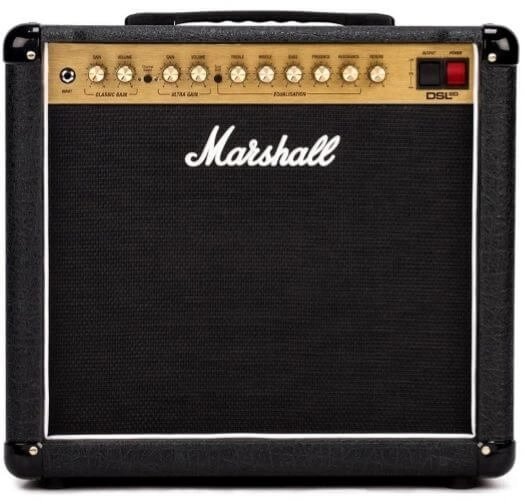
The higher-wattage DSL models are best for intermediate to advanced guitarists.
However, there are lower-wattage variants of the DSL, including a small 5-watt combo, that would be well-suited to a beginner.
Characteristics
DSL stands for Dual Super Lead and does precisely what the name implies.
It’s a hot-rodded version of the classic Marshall Super Lead circuit, using EL34 power amp valves to achieve the classic Marshall tone.
To provide the power and saturation we have become accustomed to, the Dual Super Lead series features a second channel labeled “Ultra Gain.”
As the name indicates, the Ultra Gain channel provides an additional gain circuit courtesy of the DSL’s ECC83 preamp tubes.
The DSL comes in various combo and head-only sizes.
They Range from bedroom-appropriate single-watt amplifiers up to an ear-shattering 100-watt version.
The DSL is a remarkably versatile rock amplifier straight out of the box…
And the DSL20C (its mid-sized 20-watt combo version) perhaps best exemplifies this.
Its first channel, labeled “Classic Gain,” delivers classic Marshall crunch.
Power chords are satisfying and clear.
Melodies sizzle and sparkle, just like your favorite records.
The “Ultra Gain” channel, which is engaged via the control panel or an external footswitch, is like kicking on a distortion pedal.
This Provides additional gain and saturation leaps from the amp, delivering searing lead tone a la Gary Moore or Justin Hawkins.
The DSL series is aimed at players in the hard rock and heavy metal genres.
So, for those looking for squeaky-clean Fender or Vox tones, you won’t find much joy here.
However, if you want headbanging riffs and solos, the DSL series may well be the amp for you.
Volume
The DSL series comes in various sizes, with the amps of larger wattage predictably delivering greater volume.
You won’t have much luck trying to keep up with a live rock band using the 1-watt DSL, but the 20, 40, and even 100-watt amps will provide more than enough volume to play with a live band.
Conveniently, the higher-wattage DSL amps come with a low-power switch.
This means you can reduce the output of the amp to assist in playing at bedroom volume.
Unlike the original Super Lead series, which lacked a master volume control, you’ll be able to engage the low power setting and use the volume knob to tame your amp’s volume while retaining some of its natural drive.
Tubes & Speaker
The DSL20C uses three ECC83 preamp tubes and two classic EL34 tubes in the power amp.
The number of these tubes varies depending on which DSL you’re using.
The 1-watt DSL has two preamp tubes and a sole poweramp tube powering its eight-inch Celestion speaker, while the 100-watt head has four of each.
The DSL40CR, the largest DSL combo, powers a sole twelve-inch Celestion V-type with four preamp valves and three poweramp valves.
Controls

The Marshall DSL’s controls are numerous and detailed, allowing for high degrees of tonal tailoring.
- The classic gain channel has gain and volume knobs, as does the Ultra Gain channel.
- The EQ is standard treble, middle, and bass.
- There’s also a tone shift switch and knobs for presence and resonance.
- Independent reverb control knobs for both channels are on the control panel.
- Bedroom players will be grateful for the inclusion of two master volume controls, one for each channel.
- There’s also a low-power switch on the amp’s rear and an on/off switch for the effects loop.
Effects & Effects Loop
The DSL comes with built-in reverb and a standard send/return effects loop.
Marshall DSL20C Dimensions
| Weight | Height | Width | Depth |
|---|---|---|---|
| 16.3 kg / 36 lbs | 420 mm / 16.5″ | 500 mm / 19.7″ | 250 mm / 9.8″ |
Price
The DSL20C retails for $699.99 on Zzounds. Your local music store may have a different price.
5. The Marshall JVM Amp
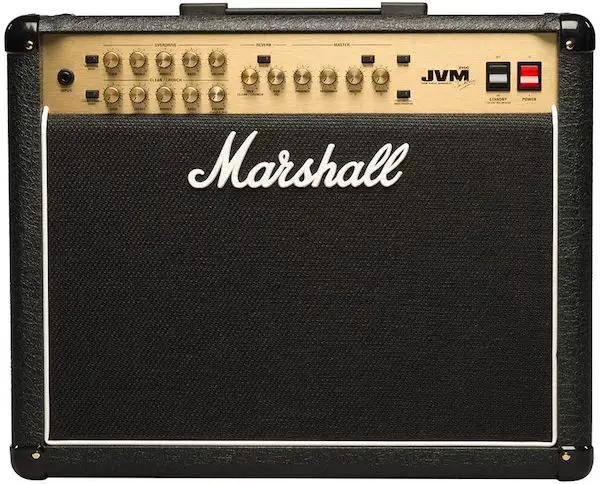
The JVM is ideal for advanced guitarists looking to fine-tune their high-gain tones.
Beginner to intermediate players may find the multiple channels and massive controls (up to 28 knobs on some models) intimidating.
Characteristics
The Marshall JVM series bears all the classic Marshall appointments:
- Black cloth,
- gold controls,
- the white script logo, and
- plenty of crunch and gain.
However, this decidedly modern amplifier has moved far beyond the extreme simplicity of the original Marshall Super Lead into a far more complicated affair.
This amp boasts four channels, which can be tweaked individually to provide unique tones in each.
You might use one for a clean tone, the next for an edge-of-breakup blues tone, the third for AC/DC crunch, and the fourth for high-gain metal saturation.
Helpfully, the JVM is also MIDI-compatible, so modern players looking to use MIDI controls and effects will find a home for their high-tech gear here.
The JVM, thanks to its high levels of tonal control, features arguably the finest clean tone of any Marshall tube amp.
The JVM amp won’t suit jazz players…
But indie, blues, funk, and pop-rock guitarists who prefer clean sounds to classic Marshall dirt will love this amp.
The JVM’s clean channel rivals that of a Vox or Fender for clarity and chime.
Like the Marshall Code, the JVM series attempts to emulate the iconic voices of Marshall’s classic amps, including the Super Lead, JCM800, and Jubilee.
Thanks to this amplifier’s preamp and power amp tubes, playing with the controls will deliver far closer approximations of these sounds than the Marshall Code series.
Volume
The JVM comes in a variety of sizes to suit a variety of needs.
The distorted tone won’t be as pleasant at low volume as at higher volume, but the JVM provides appropriate volume for bedroom players and aspiring arena rockers.
Tubes & Speaker
The JVM 215C provides 50 watts of Marshall grunt thanks to its sole 12″ Celestion G12 speaker.
Higher-wattage JVM combos come with an additional 12-inch speaker.
There are 4 ECC83 valves in the preamp and two EL34 in the power amp.
Controls
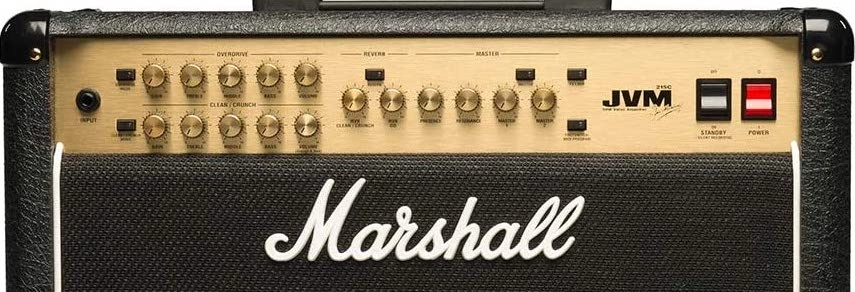
The JVM series boasts some of the most complex and multitudinous controls of any Marshall amp.
This includes channels and modes select button.
Each channel has its own gain, treble, middle, bass, volume, and reverb knobs.
The Marshall JVM also has a master presence, resonance, and master volume control switchable for each channel.
Effects & Effects Loop
The M has Marshall’s usual built-in overdrive and reverb effects and two effects loops: one parallel and one series.
Dimensions
| Weight | Height | Width | Depth |
|---|---|---|---|
| 26.5 kg / 58 lbs | 510 mm / 20.1″ | 605 mm / 23.8″ | 265 mm / 10.4″ |
Price
The JVM215C retails for $2,699.99 on Amazon. Your local music store may have a different price.
6. The Marshall ORIGIN Amp
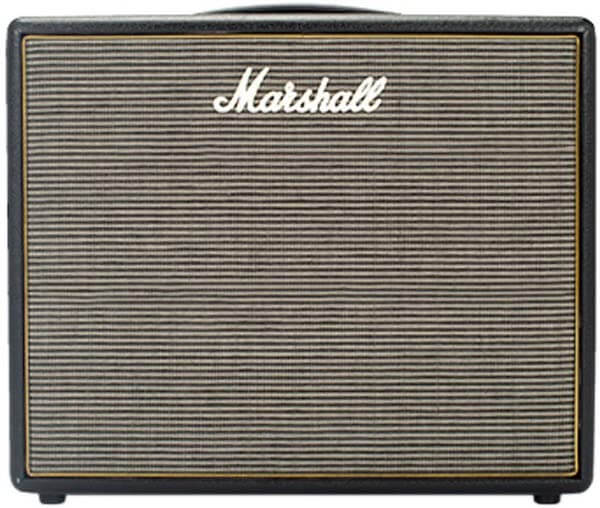
Ideal for players of all ability levels, the Origin series is Marshall’s most “neutral” amplifier.
Characteristics
Marshall amplifiers are notorious for having a unique, particular tone.
They don’t play as nicely with as many pedals as, say, a Fender blackface.
However, there are the classic Marshall pairings.
They sound great with Gibson and Fender guitars and seem to respond well to vintage-voiced overdrive pedals.
However, for many guitarists, tweaking the Marshall’s natural tone to suit their instrument and stompboxes of choice may not be an option.
For many, this characteristic Marshall growl is why they love Marshalls…
But those who rely on a pedalboard for most of their tone tend to eschew Marshalls for other, more neutrally voiced amps.
That’s where the Origin series comes in.
These all-valve amplifiers are optimized for those who want to create their unique sound rather than reusing the classic Marshall tone.
Marshall Origin amps have a surprising amount of headroom and rich, harmonic tones that respond well to just about any tonal tweaking you might be inclined to do.
Volume
Marshall’s Origin series goes all the way from a five-watt offering to a fifty-watt combo or head.
The 20-watt combo is probably the most versatile of these.
Capable of performing at bedroom volume or keeping pace with a live band.
Thanks in no small part to its 0.5, 3, and 20-watt power soak options.
The fifty-watt combo neither will make your neighbors very happy nor will do much to endear you to an audience at any venue bigger than your bedroom.
Tubes & Speaker
The Marshall Origin 20C features a sole ten-inch Celestion VT Junior.
The preamp and power amp are classic Marshall: three ECC83 tubes in the preamp and two EL34s in the power amp.
Controls
The Origin’s controls are something of a departure from the classic Marshall setup.
Of course, the usual volume, gain, master, presence, and EQ controls are there, but there’s also a nifty little control called the Tilt.
Effectively, the Tilt control allows you to blend the Origin’s normal channel with its treble-boosted channel to fine-tune your amp’s unique tone.
Effects & Effects Loop
The Marshall Origin does not come with any effects built-in, but it will respond well to just about anything you throw at it.
It will retain your guitar’s natural tone through any pedals thanks to its Series send/return effects loop.
Marshall Origin 20C Dimensions
| Weight | Height | Width | Depth |
|---|---|---|---|
| 13.9 kg / 31 lbs | 440 mm / 17.3″ | 13.9 kg / 31 lbs | 240 mm / 9.4″ |
Price
The Marshall Origin 20C retails for $564.22 on Amazon. Your local music store may have a different price.
7. The Marshall Bluesbreaker Amp
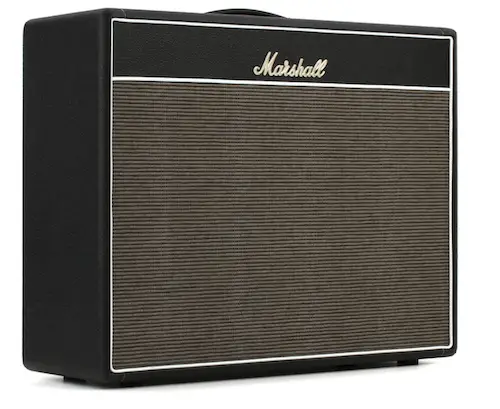
The Bluesbreaker amp is ideal for intermediate to advanced guitarists looking to capture the iconic tones of the 1960s British blues boom.
Characteristics
This mighty 2×12 combo was named for the jaw-dropping performance Eric Clapton delivered with it while playing with John Mayall’s Bluesbreakers.
At the time, Marshall called it “1962”, despite it being produced first in 1964.
Surprisingly, it’s far from the loudest amplifier in the Marshall range and certainly is no competition for the more famous Super Lead series.
However, it’s an integral ingredient in chasing Clapton’s iconic tone, and the modern reissue recreates the precise styles of this classic era.
Happily, the Bluesbreaker looks the part, with its cloth grille and flat front.
It’s as if the amplifier stepped out of 1964 and onto your stage.
This is a faithful recreation of Marshall’s first combo amp, from its appearance to its distinctive tone.
Volume
At thirty watts, the Bluesbreaker isn’t the loudest amp on this list, but it’s far from the quietest.
It won’t be appropriate for bedroom playing, but for gigs and rehearsal, you’ll be thrilled.
Really, this amplifier is built to do one thing and one thing only, to deliver high-octane British blues-rock tones in spades…
And it does so at window-rattling volume.
Tubes & Speaker
The Bluesbreaker is armed with twin twelve-inch Celestion G12M-25 speakers, just like the original 1962 amplifier.
These 25-watt speakers aren’t quite as powerful as those found in later Marshall cabinets…
Such as those used by The Who’s Pete Townshend, but they’ll deliver plenty of grunt and power for most venues.
There are four ECC83 valves in the preamp, two 5881 valves in the power amp as correct for the early sixties, and a GZ34 rectifier.
Controls

The Bluesbreaker is notable among Marshall amps for featuring tremolo controls.
In addition to volume controls for the amp’s two channels, there is bass, mid, and treble EQ controls and controls for the tremolo speed and intensity.
Effects & Effects Loop
Because effects pedals for guitars didn’t really exist in 1962, this amplifier has no effects loop.
Dimensions
| Weight | Height | Width | Depth |
|---|---|---|---|
| 30.2 kg / 67 lbs | 610 mm / 24″ | 740 mm / 29.1″ | 265 mm / 10.4″ |
Price
The Marshall 1962 Bluesbreaker retails for $3,699.99 on Sweetwater. Your local music store may have a different price.
8. The Marshall JTM45 Amp
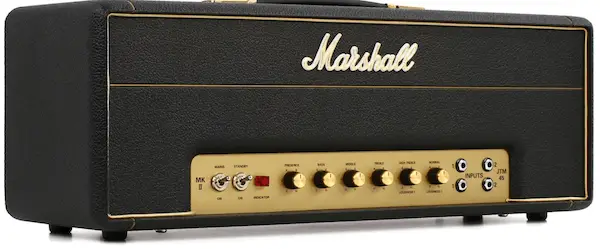
Ideal for advanced guitarists looking for the specific, iconic sound of Marshall’s most desirable amplifier.
Characteristics
The JTM45 head, first produced in 1963, was the amplifier that built the Marshall brand.
It was the first Marshall amp to knock Vox off their perch as the best-selling British amplifier company.
The JTM has a distinctive tone halfway between the Fender tweed amplifiers and the iconic Marshall sound of the later Super Lead series.
It uses two channels – one bright, one normal – not unlike the Vox AC30, with which the JTM45 was a direct competitor.
The JTM was the basis for most Marshall amplifiers, and although it was only made in its initial run from 1962-1968, the Marshall JTM45 remains one of the most sought-after amplifiers in the world.
The recent reissue captures all the magic of the original Marshall head.
The JTM45 is best suited to classic rock and blues, as its lack of advanced gain staging makes it inappropriate for heavy metal.
Volume
At only thirty watts, you could be forgiven for thinking the JTM45 isn’t very loud.
However, the JTM45 provides plenty of volume and actually sounds better the louder you play it.
Besides, it’s loud enough for AC/DC’s Angus Young, who purportedly uses a JTM45 live to this day.
Tubes & Speaker
As the JTM45 is only an amplifier head, there are no speakers.
The JTM45 has three ECC83 valves in the preamp and two 5881 valves in the power amp.
Like the Bluesbreaker, it also features a rectifier, this time a GZ34.
Controls

The JTM45’s controls are simple and easy to use.
Presence, bass, mids, and treble controls adorn the panel in addition to volume controls for both channels.
Effects & Effects Loop
No built-in effects and no effects loop, as is accurate for the Marshalls of the 1960s.
Dimensions
| Weight | Height | Width | Depth |
|---|---|---|---|
| 14.6 kg / 32 lbs | 265 mm / 10.4″ | 665 mm / 26.2″ | 205 mm / 8.1″ |
Price
The Marshall JTM45 reissue retails for $2,799.99 on Sweetwater. Your local music store may have a different price.
9. Marshall 1974X
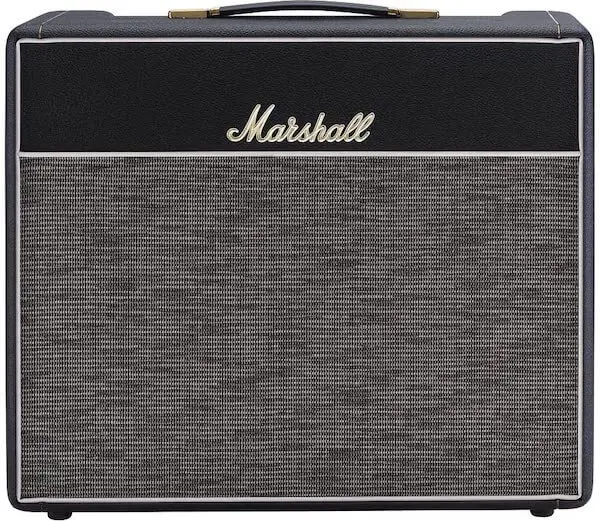
Ideal for advanced guitarists pursuing the iconic late Sixties Marshall tone.
Beginners and intermediate guitar players who are still learning and have not specialized in the genres of music appropriate for this amp won’t enjoy it much.
Its touch sensitivity will punish sloppy playing as much as it rewards precision and subtlety.
Characteristics
Despite its name, the 1974X is a reissue of the original Marshall 1974 amp, first produced in 1966 and 1968.
Its lower wattage allows it to break up and provide overdrive at lower volumes than the Bluesbreaker or JTM reissues.
The original 1974 series was renowned for its sensitivity to a player’s dynamics.
This amp will sound different based on how hard you play your guitar and articulate each note.
This unmatched articulation makes the 1974X ideal for studio use, although it is by no means unfit for the stage.
It will deliver classic overdriven 1960s Marshall tone at a lower volume than its hand-wired brethren, the Bluesbreaker, and the JTM45.
Volume
This amp’s 18 watts are more than enough to play with a band or at a gig.
Just keep in mind that, like all classic Marshalls, it’s probably too loud to play at home unless you’ve warned any neighbors and roommates that you’ll be practicing.
Tubes & Speaker
The 1974X reissue is powered by a single 12-inch Celestion Heritage Greenback speaker, which has been aged to achieve the specific vintage tone of the original 1974.
The valve setup is, predictably, classic Marshall.
Three ECC83 preamp valves, with twin EL84s in the power amp.
Controls
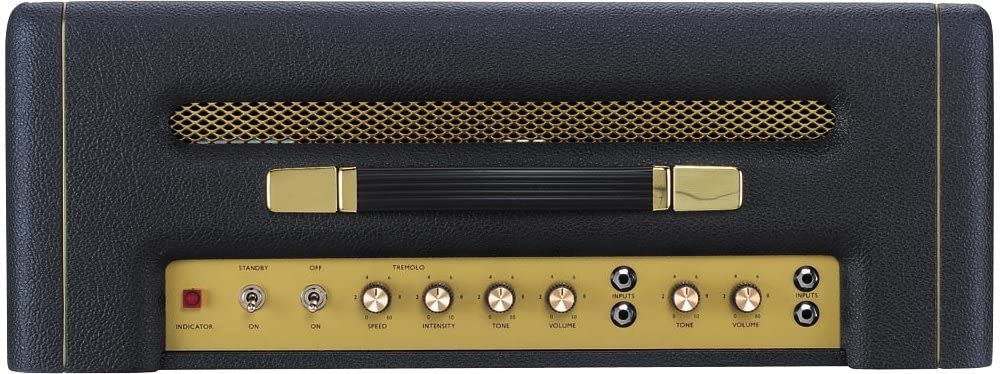
If you thought the JTM45’s controls were brutally simple, this one would blow your mind…
With no EQ knobs, the 1974X only has:
- Channel 1 controls for tremolo speed, tremolo intensity, tone, and volume, and
- Channel 2 controls tone and volume.
Effects & Effects Loop
The 1974X has a single tremolo channel and no effects loop.
It’s bare-bones classic rock all the way through.
Dimensions
| Weight | Height | Width | Depth |
|---|---|---|---|
| 30.2 kg / 67 lbs | 610 mm / 24″ | 740 mm / 29.1″ | 265 mm / 10.4″ |
Price
The Marshall 1974X retails for $3,599.99 on Amazon. Your local music store may have a different price.
10.Marshall 1987X

Ideal for intermediate to advanced guitarists looking to replicate the iconic rock tones of the 1970s.
Characteristics
This is a lovingly crafted fifty-watt head reissue that graced so many classic 70s hard rock records.
The sparkling cleans and blistering overdrive that you expect from Marshall are here, as is the classic four-hole input.
This amp has an effects loop, the only feature done to bring this amp to the modern era.
The amp produces a pleasant classic rock drive with the volume knob around two, and as it gets louder, this saturation gets sweeter.
Volume
This is a fifty-watt vintage-voiced Marshall.
It’s loud!!!!
Not at all appropriate for bedroom rehearsal, but it will rock venues as large as you like.
You’ll need hearing protection if you plan on using this amp for its intended purpose: arena-ready rock and roll.
Tubes & Speaker
As an amp head, the 1987 has no speaker.
Its tone comes from the combination of two EL34 power amp tubes and three ECC83 preamp tubes.
Controls

The 1987X’s controls are Marshall Plexi standard, presence, bass, middle, treble, high treble/loudness I, and normal/loudness II.
You can “jump” the channels with a patch cable (not included) and use the loudness knobs to blend the amp’s tone to your personal taste.
Effects & Effects Loop
The 1987X lacks built-in effects…
But thankfully, for those who want to add reverb, delay, or Eddie Van Halen-like phase, there’s a standard send/return effects loop.
Dimensions
| Weight | Height | Width | Depth |
|---|---|---|---|
| 14.6 kg / 32 lbs | 265 mm / 10.4″ | 665 mm / 26.2″ | 205 mm / 8.1″ |
Price
The Marshall 1987X retails for $2,799.99 on Zzounds. Your local music store may have a different price.
11.Marshall JCM 800
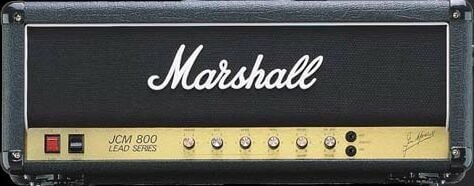
Ideal for intermediate to advanced players looking for the searing, headbanging sound of 80s metal.
Characteristics
Before you buy the JCM 800 Marshall amp, ask yourself, do I like the sound of 80s metal?
If you answered yes, this is the amp for you. If not, look elsewhere.
The JCM800 was Marshall’s way of hot-rodding their iconic Plexis to meet the demands of guitarists looking for more and more distortion.
Gone were the days of early breakup and blues-based rock.
JCM800 players wanted the high-gain saturation of Metallica and Slayer, not the bright, articulate sound of Led Zeppelin.
Even the MTV-ready pop-metal of Warrant, Def Leppard, and Poison was fuelled by the Marshall JCM800.
Perhaps the best example of the JCM800’s distinctive tone is Ozzy Osbourne axeman Zakk Wylde and his thick, meaty distortion as heard on No More Tears.
Much of this additional distortion comes from the amp’s separate preamp volume tone, which allows you to run extra power through the preamp without pushing the speakers and power amp.
Simply put, you can increase distortion without massively increasing volume.
The JCM800 will make your pinch harmonics scream, and your palm mutes chug.
Power chords and solos will seek and destroy.
The JCM800 is not an amplifier for the faint-hearted.
Volume
The JCM800 comes with a master volume knob.
This means you can dial in a wild distorted tone and pull the volume back to acceptable levels, unlike previous Marshall amplifiers.
The JCM800 gets loud enough to play any sized venue, and although it may be a little too loud for some home practice, its master volume knob allows you to play at lower volumes while retaining your saturated tone.
Tubes & Speaker
The JCM800 head has no speakers.
It delivers 100 watts of Marshall power thanks to its three ECC83 preamp tubes and four EL34 power amp tubes.
Controls

This single-channel amplifier is endearingly simple.
Its gold faceplate has knobs to control presence, bass, middle, treble, master volume, and preamp volume.
Effects & Effects Loop
No built-in effects, but the JCM800 does have a serial switchable effects loop.
Dimensions
| Weight | Height | Width | Depth |
|---|---|---|---|
| 19 kg / 42 lbs | 535 mm / 21.1″ | 610 mm / 24″ | 230 mm / 9.1″ |
Price
The JCM800 retails for $3,349.99 on ZZounds. Your local music store may have a different price.
12. The Marshall Jubilee Amp
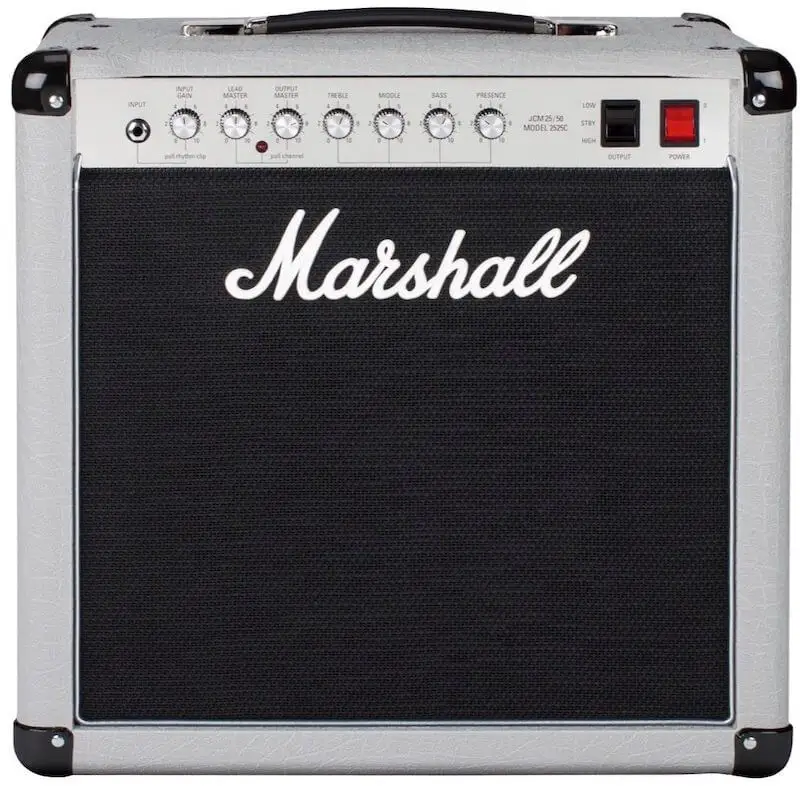
Ideal for advanced guitarists looking to use the specific sound of the original Marshall Jubilee.
Characteristics
1987 marked the 25th year of Marshall’s existence.
25 years at the top of the amp business meant that Marshall produced a distinctive-looking and even more unique-sounding amplifier.
The Silver Jubilee series was covered in silver vinyl with chrome faceplates instead of Marshall’s traditional black-and-gold trimmings.
The Jubilee was made most famous by Guns N’ Roses axeman Slash, who frequently used the amp during the Guns N’ Roses heyday of the late 1980s and early 1990s.
The Jubilee series was effectively a modified version of the JCM800.
It contained a valve output stage that allowed switching from full power ‘pentode’ mode to half-power ‘triode’ mode, a rudimentary version of the power-switching feature now standard in modern amps.
100W heads could be reduced from 100W to 50W, and 50W heads could be reduced to 25W.
Some closely-guarded clever engineering meant these amps had a silkier, smoother tone than the bright, aggressive JCM800 amps.
The Marshall Silver Jubilee is out of production, but the Studio series has resurrected the Jubilee in spirit, in the form of its 20 watts 2525C Studio Jubilee.
Volume
These are loud amps, but as with the JCM800, the inclusion of a master volume knob will allow you to tweak the volume.
Bedroom players will appreciate the Jubilee’s early power soaking feature, but this amplifier was meant to be played in front of a full-powered rock band.
Tubes & Speaker
The 2525C Studio Jubilee has a 12 inch Celestion speaker and two ECC83s in the preamp, along with an ECC83 phase splitter and two EL34s in the power amp.
Controls
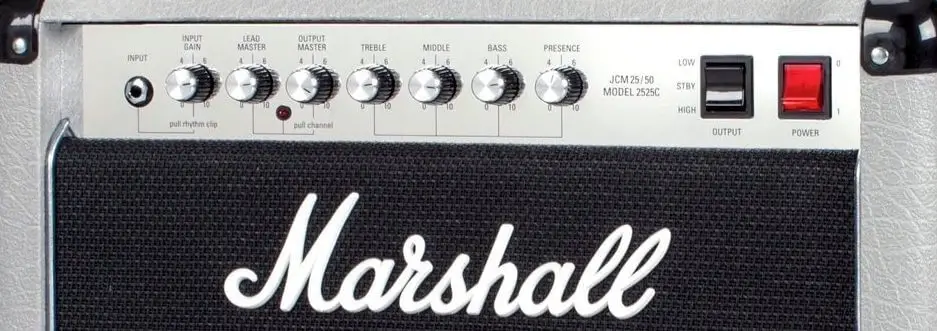
The controls for the 2525C Studio Jubilee are similar to that of the JCM800; presence, bass, middle, treble, output master, channel select, and lead master.
There’s also a helpful input gain control for fine-tuning the gain stage.
Effects & Effects Loop
The Silver Jubilee has a built-in send/return effects loop.
2525C Studio Jubilee Dimensions
| Weight | Height | Width | Depth |
|---|---|---|---|
| 15.3 kg / 34 lbs | 260 mm / 10.2″ | 660 mm / 26″ | 205 mm / 8.1″ |
Price
The 2525C Silver Jubilee retails for $1,799.99 on Zzounds. Your local music store may have a different price.
13. The Marshall JCM900 Amp

Ideal for intermediate to advanced guitarists.
The JCM900 is effectively a JCM800 with an additional gain circuit built-in, ideal for those looking for a little more crunch and saturation than the JCM800 provides.
Characteristics
Just as the JCM800 was Marshall’s way of addressing gain-hungry guitarists at the beginning of the 80s, so too was the JCM900 an attempt to provide even more saturation at the dawn of the 90s.
Many metal and hard rock guitarists were supplementing the already high-powered gain of the JCM800 with distortion pedals such as the Tube Screamer or Boss Super Overdrive.
Marshall decided to capitalize on these additions and build the JCM900 with a distortion pedal built into the amp.
It also features an extra channel compared to the single-channel JCM800, allowing players to switch between lead and rhythm tones using the included PEDL-91004 foot controller.
Think Stone Sour, Rise Against, and, incongruously, Oasis circa Be Here Now for the JCM900’s tone.
Volume
Like its predecessor (the JCM800), the JCM900 is a loud amp built to rock stadiums.
Its master volume control will help tame it for practice and rehearsal, but this is not an amp made for quiet practice.
Tubes & Speaker
The JCM900 head has no speaker.
The preamp has the same specs as the JCM800, with three ECC83 valves and an extra ECC83 for a phase splitter.
The power amp, however, uses high-gain 5881 valves.
Controls

The JCM900 allows for individual channel control. Channel B has controls for volume and reverb, and channel A has the same.
There are also knobs for presence, bass, middle, treble, channel B lead gain, and channel Again.
Effects & Effects Loop
The JCM900 has an effects loop with level control.
Dimensions
| Weight | Height | Width | Depth |
|---|---|---|---|
| 20.5 kg / 45 lbs | 315 mm / 12.4″ | 740 mm / 29.1″ | 210 mm / 8.3″ |
Price
The JCM900 reissue retails for $2,799.99 on Amazon. Your local music store may have a different price.
Conclusion
With over 50 years of making fantastic amps, Marshall has 13 different types of amps to suits any level of player from beginner to advance.
The 13 marshall amp types described in this article were:
- The Marshall Studio Vintage amp, in particular the SV20C, suit intermediate to advanced player.
- The Marshall Code amp, in particular the Code 25, suit intermediate players.
- The Marshall MG amp, in particular the MG30FX, suit beginner players.
- The Marshall DSL amp, in particular the DSL20C, suit intermediate to advanced guitarists.
- The Marshall JVM amp, in partucular the JVM215C, suit advanced guitarists.
- The Marshall Origin amp, in particular Origin 20C, suit players of all ability levels.
- The Marshall Bluesbreaker amp, in particular the 1962 Bluesbreaker, suit intermediate to advanced guitarists.
- The Marshall JTM45 amp, in particular the JTM45, suit advanced guitarists.
- The Marshall 1974X amp, in particular the 1974X, suit advanced guitarists.
- The Marshall 1987X amp, in particular the 1987X, suit intermediate to advanced guitarists.
- The Marshall JCM 800 amp, in particular the JCM800, suit intermediate to advanced players.
- The Marshall Jubilee amp, in particular the 2525C Silver Jubilee, suit advanced guitarists.
- The Marshall JCM900 amp, in particular the JCM900 reissue, suit intermediate to advanced guitarists.
